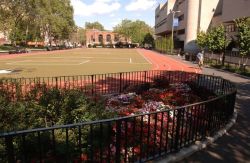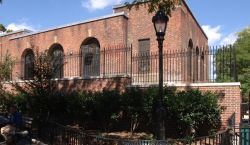Sara D. Roosevelt Park
M’Finda Kalunga Garden
The M’Finda Kalunga Garden is named in memory of an African-American burial ground that was located on Chrystie Street near Stanton Streets.
The Dutch West India Company brought the first enslaved Africans to the indigenous Lenape’s Manahatta in the early 1600s. By 1748, African-Americans, enslaved and free, were 20% of the city’s population. Though New York City was dependent on their labor, Black residents endured curfews, meeting prohibitions, burial restrictions and outright bans. African-Americans were barred from membership in churches, at best relegated to balconies and back pews, and with the closing of the African Burial Ground in 1794 no other sites existed for their internment.
In 1794 the Common Council of New York City received a petition from the African Society “to procure a place for the internment of People of Colour.” By April, the land was granted in what was deemed “a proper place,” near the dilapidated ruin of James Delancey’s mansion. The Common Council Minutes of July 6, 1795 relate:
“A Release from Samuel and Phila Delaplaine [local abolitionists] to this Corporation of two Lots of Ground near where the old dwelling House of James Delancey stood in the 7th Ward in trust for the use of the black people as a burial Ground; was read & approved by the Board & ordered to be recorded & deposited among the Corporation Deeds.”
St. Philip's Church, a mission of Trinity Church, took charge of the site, but by July 1835 the cemetery, in use forty years, was full and new laws would make it illegal to bury others. In 1853, the Chrystie Street Burial Ground closed forever. The human remains were disinterred and sent to Cypress Hills Cemetery in Brooklyn. The M’Finda Kalunga Garden, or “Garden at the Edge of the Other Side of the World” in the Kikongo language, memorializes this history.
The garden was founded in 1983, as a project of the Roosevelt Park Community Coalition. The coalition was formed in 1982 in response to an overwhelming drug problem in the park, and to solve problems facing the neighborhood. The original aims of the garden were more social than horticultural. The organizers viewed their work as a beachhead from which to launch initiatives that would make the community a better place to live. In the following years, many gardeners and volunteers have joined the project.
About 40 gardeners, including residents from the attached low-income senior center, maintain individual beds and contribute to the upkeep of communal areas. The garden serves as protected space for residents during the week and is open on weekends and at other posted times to the general public. Garden keys and individual plots are earned on an apprenticeship basis. Offers to volunteer are always welcome. Anyone who wishes to become a member is warmly invited to monthly meetings.
Check out your park's Vital Signs
Clean & Safe
Green & Resilient
Empowered & Engaged Users
Share your feedback or learn more about how this park is part of a
Vital Park System










